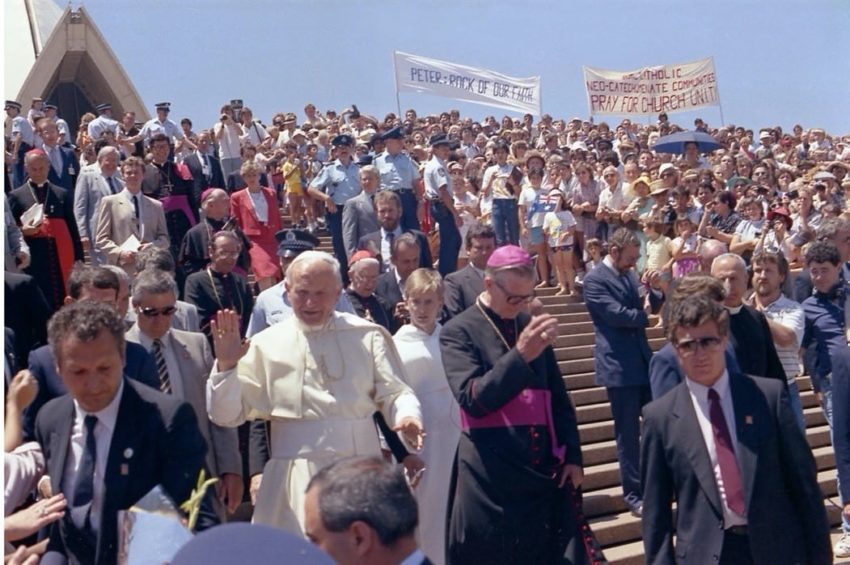
Memories of a most influential and beloved pope
Archbishop Anthony Fisher OP reveals the incredible personality and legacy of St John Paul II and his own memories of the saint in this exclusive interview with The Catholic Weekly to mark the centenary of his birth on 18 May 2020.
Your Grace, you were chosen as a bishop by the now-Saint John Paul II. Do you have any personal reminiscences or experiences you can share of him?
I first saw Pope John Paul on 24 November 1986. He began his visit to Australia with a Mass in Canberra where I was a Dominican novice. He said he had come as a pilgrim of faith to the ‘South Land of the Holy Spirit’ (as the Portugese explorers had called it), the continent over which a Cross of stars shone.
He spoke of the faith and heroic service of the first priests, bishops and nuns in this land to the convicts and settlers, unprotected women, Aborigines and ‘the scattered flock of the interior’ – “a great throng of witnesses who have gone before us”. And he invited us to see that, for us Australians, “the Way to the Father’s house passes through this land” – this “place of your joys and pains, your endeavours and hopes”. It was inspiring for a young priestling to hear.
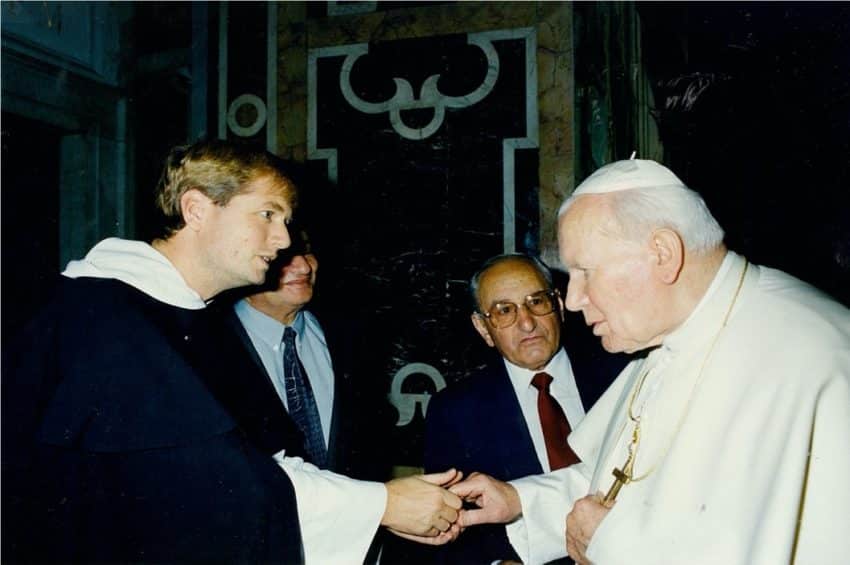
Two days later we novices travelled to Sydney to attend John Paul’s meeting with religious at the Sydney Opera House. (The SOH website says that “Performers and presenters have included Pope John Paul II, Aung San Suu Kyi, Ella Fitzgerald, Luciano Pavarotti, Julie Andrews, Nigella Lawson, Germaine Greer…and Prince, to name a few.” I think John Paul the actor would enjoy heading such a line-up of stars!) One of us (Br Martin) pushed through the crowd, climbed a barrier and threw himself at the saint to kiss his hand: I was rather more decorous and stood back, but my time would come…
The first time I met him personally was in the Sala Clementina – the big, beautiful audience hall in the Vatican – in 1997 with Dr Joe Santamaria. I think John Paul would have met and encouraged every human being on earth if he could: so at papal audiences, rather than meet a limited few, he’d try to speak to every attendee individually. As a result he was always late for his next meeting!
I think John Paul would have met and encouraged every human being on earth if he could
On that occasion we made a big circle and he went from person to person, shaking hands and talking to them. I was introduced as a young priest from Melbourne (I was living and working there at the time). With a twinkle in his eye he said, “Melbourne? … I remember Sydney.” He couldn’t have known I was a Sydney boy, but I suspect he knew of the rivalry between the two cities. It was typical of his sense of humour. Perhaps that’s when he got the idea of bringing me home to Sydney as a bishop one day.
I met him about ten times after that. He appointed me as a member of the Pontifical Academy for Life (the Vatican’s bioethics think tank) and it had an audience with him annually. Around that time each year he would also visit the Dominican headquarters, Santa Sabina, to celebrate Ash Wednesday Mass, and so I received the ashes from him on several occasions.
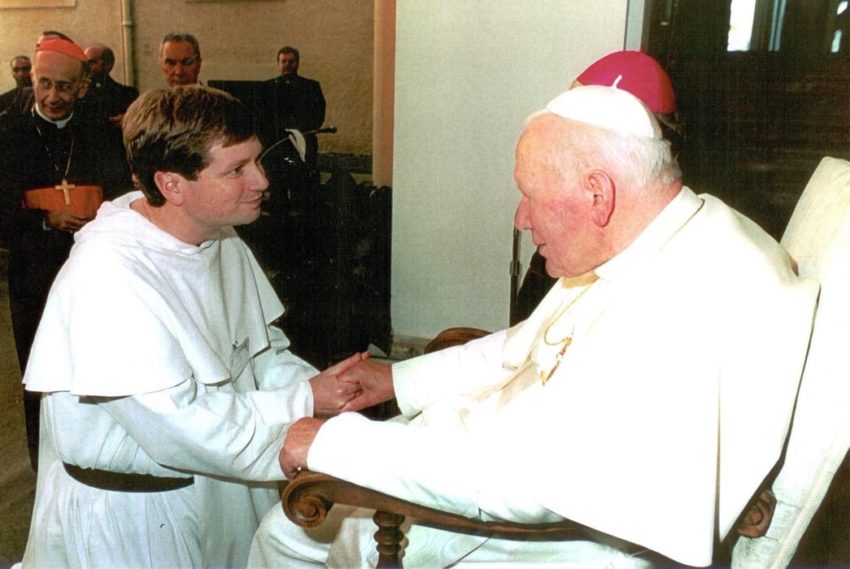
I met him again in 1999 at the Apostolic Palace in Castel Gandolfo. He was told I was to be Rector of the proposed Melbourne campus of the John Paul Institute for Marriage and the Family. He was visibly astonished that this ‘child’ was assuming such a role (I was actually 39 years old). All the leaders and teachers of the Institute from around the world engaged in discussion with him at that seminar, each in their own language, and the saint responded in whatever language we spoke as if he were an apostle at Pentecost.
What would you nominate as his chief contributions to the Church and the papacy? What made him so important?

Jesus wrote the job description for the papacy not us. Peter was to ‘come follow Me’, be made ‘a fisher of men’, a shepherd of Christ’s sheep, a carer for His lambs, and a ‘rock’ for the Church. This was so Peter could ‘go out to all the world, telling the Good News’, so what he bound or loosed on earth would be so in heaven, so the forgiveness he had experienced could be granted to others, and so he could ‘confirm the brethren’.
At their last meeting on earth, Peter repented of his three denials but Jesus was more interested in provoking protestations of love. He then hinted where that love would lead him. Peter would be ‘papa’ or pope and shepherd for the Church in difficult times and be taken where he’d rather not go, all the way to the city of Rome, where he would give his ultimate witness to Christ.
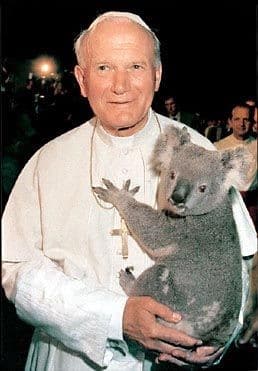
John Paul likewise had to leave his Polish homeland to venture to Rome and the world. His longest pilgrimage of many was in 1986, when he made the extraordinary journey to Bangladesh, Singapore, Fiji, New Zealand, Australia and the Seychelles. Here in Sydney he held hands and danced with youngsters in jeans.
In Melbourne he conducted an impromptu Q&A with primary school children. In Alice Springs he encouraged Aboriginal elders in their struggle for justice and reconciliation. In the newly-created diocese of Parramatta he wore a hardhat in a factory.
In Brisbane he cradled a koala… He returned in 1995 to beatify Mary MacKillop.
When he wasn’t in places like Australia he was at home writing his extraordinary corpus of encyclicals and addresses that will inform the magisterium for centuries to come.
He was an inspiration. He was a saint.
He exemplified the very Catholic integration of faith and reason in all his teaching, and made major contributions to moral theory, bioethics, the theology of the body, social justice and the family through his teaching. He founded World Youth Day and other adventures in ‘the new evangelisation’.

As the most influential pope in a millennium, John Paul remodelled the papacy for the Church, perhaps creating some unreal expectations.
But he was truly, as Peter was, a follower of Christ, fisher of people, feeder of the sheep, tender of the youth, proclaimer of the Gospel, agent of mercy, bedrock of the Church, confirmer of his brethren (the bishops and faithful). He was an inspiration. He was a saint.
St John Paul II was also a highly-respected figure on the world stage – for example in relation to events such as the collapse of the former Soviet Union and communism. How would you assess his contribution to civil society – quite apart from the Church?
With four million people in attendance in Rome, John Paul II’s was the biggest funeral in history. The celebration of his life and grief at his death was remarkable. Even the mainstream media were overwhelmingly sympathetic!

We Catholics like our litanies: long lists of names to describe God or the Blessed Virgin or another saints as we ask for their help. The secular media engaged in a kind of unwitting litanising in headlines that celebrated him as the ‘actor-athlete turned scholar-pope’; the ‘champion of human freedom’ and ‘slayer of communism’; the ‘advocate of peace and reconciliation’; the ‘champion of the civilisation of life and love’ and ‘enemy of the culture of death’; the great friend of youth, of the family and of the voiceless; the ‘millennial pope’; above all, ‘John Paul the Great’.
And his impact on the world was truly extraordinary. People talk of the ‘John Paul II generation’: actually, there were JP2 generations plural. His role in recovering balance and confidence in the Church after the rocky 1960s and 70s was crucial. So was his opposition to totalitarianism, especially the communism in Eastern Europe and Russia that he helped defeat. He was such a large figure on the world stage that he redefined the papacy’s role not just in the Church but in the world, as the greatest moral authority.
If you want to know more about his story and his effect on the world, I recommend George Weigel’s excellent biography Witness to Hope: The biography of Pope John Paul II.
He spoke to you provocatively about religious life in Australia?
The last time I met him was as at the 2004 Ad limina. (The Ad limina is a five-yearly pilgrimage of a nation’s bishops to the tombs of the apostles and to meet the pope and departments in Rome.)
Though I was now dressed as a bishop John Paul clearly remembered I was a Dominican because he asked me about the state of religious life in Australia. I explained that religious had built up much of the Church’s infrastructure and ministries over two centuries. But, sadly, religious life was in decline in Australia as in much of the West.
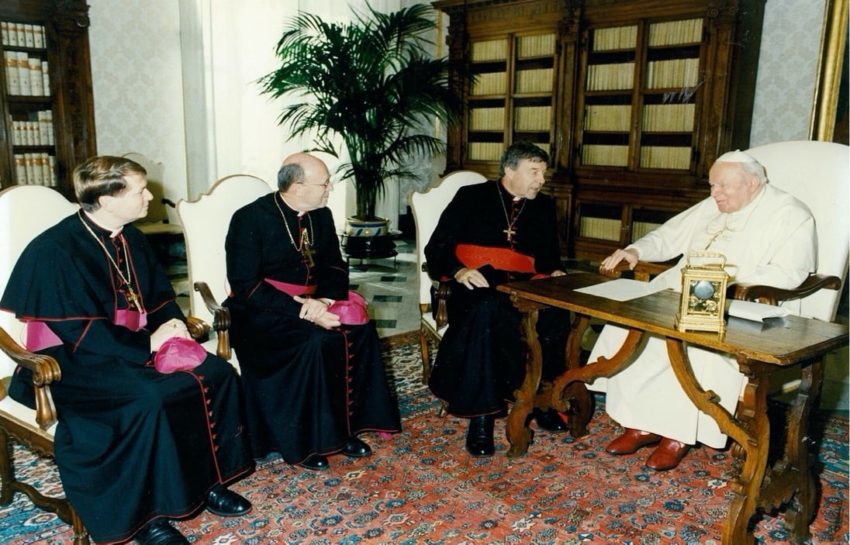
He then asked me how many kangaroos there were in Australia. I confess that my immediate thought was that his mind was wandering. He was, after all, very sick, very frail by then. ‘I think there are about 40 million kangaroos,’ I answered – twice as many as there were people. Quick as a flash he replied, ‘Well, I want more religious than kangaroos.’ His mind wasn’t wandering at all. With humour he was giving me a particular charge.
When I got back to Australia I discussed with the Cardinal what I might do to take up that charge. Clearly there had to be efforts to renew the survivors amongst the older religious congregations in Australia and to encourage the newer ones. But we agreed that we might learn some things from the orders doing well overseas, and perhaps get them to come and join us here.
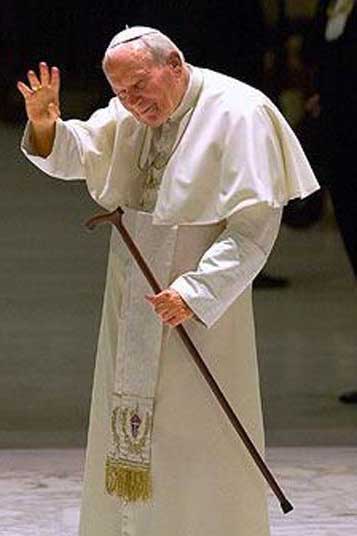
Soon after that I went to the USA to look at which seminaries and convents were thriving. I came back telling the Cardinal that World Youth Day seemed to be a big part of the story, little knowing where that might take me… But I had also been on a fishing expedition to get the Nashville Dominican Sisters, the Alma Mercies and the Sisters of Life to set up out here. I told them I was convinced there were vocations waiting for them here!
So far more than 20 Aussie women have discerned their vocation with the Nashville Dominicans and 12 are presently sisters. Others have joined the Alma Mercies or Sisters of Life. Fledgling convents of other congregations or movements have also grown up here. There is hope for religious life in Australia after all – though I may have to cull the kangaroo numbers if I’m to fulfil John Paul’s mandate!
What did he teach by the way he aged and died?
John Paul taught by his ageing, frailty and dying what he taught in his living: that from womb to tomb every human life is precious, that it is divinely created, redeemed and destined, and that it must ever be supported and never attacked.
His long slow dying seemed to some too long drawn out and his passing a relief. But this Pope could not have died in any other way: his dying put into practice his teachings about hope, courage, perseverance, dignity in old age and frailty. It made concrete the words he took from Jesus as a motto for his papacy: ‘Be not afraid!’ And it rendered to God and His Blessed Mother that which he promised in his coat of arms, ‘Totus tuus – all yours’. He gave his all, and his all was a great deal.
What sorts of things do you think made him different from his predecessors? And why was he different? Do you think he had an effect on men and women of any faith or no faith at all?

The Church has been led by many great popes – and some less worthy. Some were great scholars, doctors of the Church who proclaimed our faith and developed our understanding; others were less intellectual, more men of piety and prayer.
Some were great evangelisers, taking the Gospel to ends of the then-known world; others focused inwardly on the administration and reform of the Church. Some rubbed shoulders with the high and mighty, others reached out more to the poor and voiceless. Some brought comfort and consolation, while others were signs of contradiction.
In John Paul II we had all of these kinds of pope: his teachings fill more book-shelves than all his predecessors put together; but he was famed for personal piety, deep prayerfulness, devotion to Christ, Mary and the Saints (many of whom he sainted).
His stubborn stance for the Catholic faith made John Paul at times a controversial figure
His pastoral journeys took him to every corner of earth, including twice to Sydney as pope, preaching the Gospel and exhorting us all to join in a new evangelisation; at home he reformed the Holy See (Pastor Bonus 1988), internationalised the curia, established new dicasteries for the family, culture, pro-life issues, social sciences and more, and promulgated a new Code of Canon Law (1983) and new Catechism of the Catholic Church (1992).
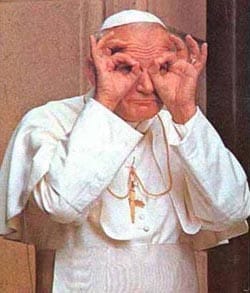 As an untiring human rights activist and peacemaker he helped bring an end to the tyranny of communism in Eastern Europe and Russia and so, also, to the cold war. He was sometimes in contest with the powers of the Western world, too, as he spoke up for the unborn, starving or dying, indeed for every human life and for its cradle, the family.
As an untiring human rights activist and peacemaker he helped bring an end to the tyranny of communism in Eastern Europe and Russia and so, also, to the cold war. He was sometimes in contest with the powers of the Western world, too, as he spoke up for the unborn, starving or dying, indeed for every human life and for its cradle, the family.
His stubborn stance for the Catholic faith made John Paul at times a controversial figure, a prophet swimming against the tide of popular opinion. But he was also a great unifier, working tirelessly at reuniting East and West in Europe, at bringing Christians back together, at engaging non-Christians in dialogue and friendship, at apologising to those we’d hurt, and at befriending the youth of the world in rebuilding ‘the covenant between the generations’.
More than all of this, perhaps, John Paul led Church and world confidently but humbly out of the twentieth and bloodiest of centuries into a new millennium with hope and vision. His was the assurance that we are not doomed to repeat the holocaust and genocides, world wars and massacre of unborn innocents, and all that went so wrong in the century past.
His was the hope that affluence can be shared, human dignity respected and God honoured above all things. In this he spoke to people of faith and to those still searching for something to believe in. And from heaven he speaks to us still.
St John Paul the Great, pray for us!
Related articles:
St John Paul II was a great, says Pope
WYD serves as a reminder of the impact of John Paul II
The Top Ten Achievements Of John Paul II
Pope Francis canonises John XXIII and John Paul II
